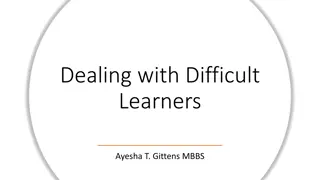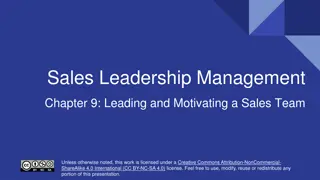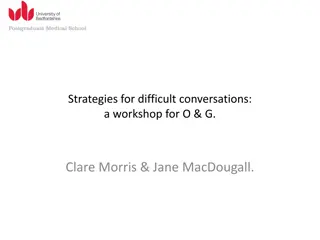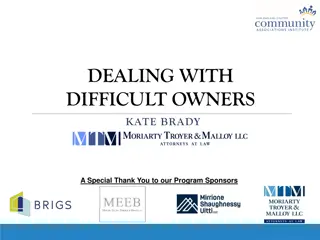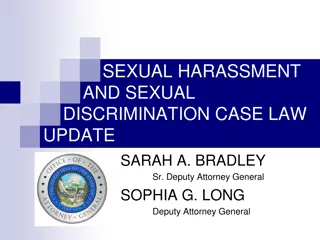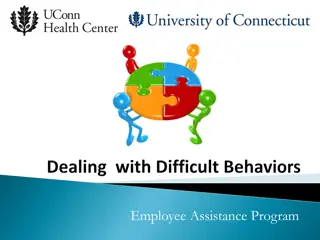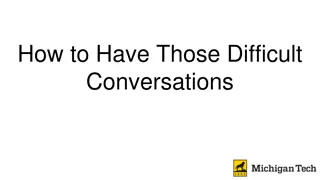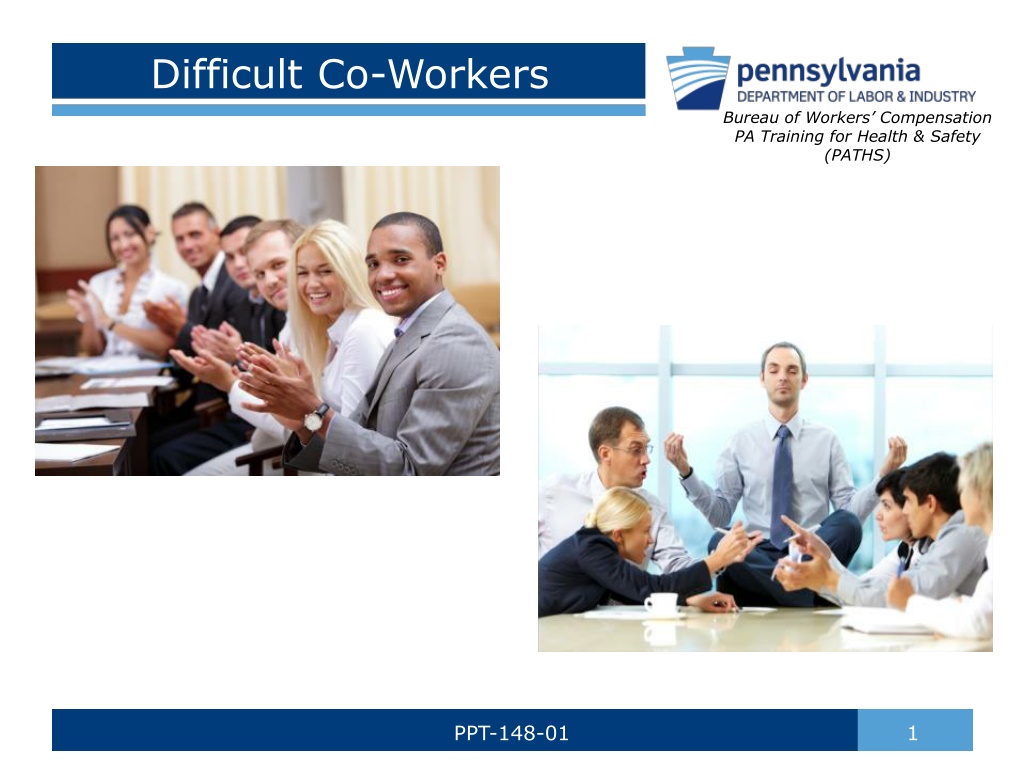
Dealing with Difficult Co-Workers in the Workplace
Learn how to navigate challenging relationships with co-workers at work. Understand the impact of difficult personalities and discover strategies for improving teamwork and productivity. Embrace differences and foster a harmonious work environment for success.
Uploaded on | 0 Views
Download Presentation

Please find below an Image/Link to download the presentation.
The content on the website is provided AS IS for your information and personal use only. It may not be sold, licensed, or shared on other websites without obtaining consent from the author. Download presentation by click this link. If you encounter any issues during the download, it is possible that the publisher has removed the file from their server.
E N D
Presentation Transcript
Difficult Co-Workers Bureau of Workers Compensation PA Training for Health & Safety (PATHS) PPT-148-01 1
Difficult Co-Workers Bureau of Workers Compensation PA Training for Health & Safety (PATHS) Each week we spend our time in a work setting. This can be in an office or a remote location. We represent our agency and must ensure we are viewed as a cohesive team. PPT-148-01 2
Work Temperament The foundation of working with others includes treating coworkers with: Kindness Dignity Respect Cooperation Harmony PPT-148-01 3
Your Organization Comprised of variously talented, experienced, and knowledgeable persons Working together toward a common goal Where differences in each person are recognized as contributing to the organization s success Sometimes disruptors in the form of difficult coworkers may be found PPT-148-01 4
Your Mission Your agency s mission is to develop and function as a team. The enemy is too often At the Gates. Generally in the form of competitors. You do not need the enemy within the gates. PPT-148-01 5
Difficult Coworkers Due to the differences within each of us, there is the potential for individuals to become difficult Refusing to cooperate on projects Refusing to work with certain individuals Allowing negatives to out- weigh the positives within the organization PPT-148-01 6
Difficult Defined Hard to be pleased or satisfied; not readily yielding; not compliant; unaccommodating; rigid; austere; not easily managed or persuaded. (Webster s Dictionary) Such temperaments can disrupt the harmony and distract you from your mission. In some cases, such conditions may be highly toxic to an organization! If permitted to continue these conditions will prove ruinous to your people and agency! PPT-148-01 7
How Co-Workers Differ There are also differences in each workplace, generational or otherwise, encompassing varying values. Some include: 1. Philosophy 2. Reasoning 3. Tolerance 4. Judgment 5. Aptitude 6. Spirituality 7. Morality 8. Work Ethics PPT-148-01 8
Outside Influences Dr. T. H. Holmes and Dr. R. H. Rahe, Life Change Units, considering the impact to a person and health risks include the areas of: Work Events Personal Issues Financial State Social Condition Family Concerns PPT-148-01 9
Mind Sets Altruistic Questioning Detached Introverted Retreating Egotistical Spiteful Complaining Extroverted Phobic Messianic Arguer Belligerent Uncooperative PPT-148-01 10
Reasons for Difficulty Personality includes the mind sets Outlook, how they view themselves in the organization or wish how others would see them Impacts on their lives over which they have little or no control Personal philosophy Problems at home brought to work PPT-148-01 11
Disruptors Confrontational Habits Issues Negativity Presumptions PPT-148-01 12
Difficulty Types Although only viewing coworkers, some of these traits can be found in bosses. These are but a few of the types: Mirror-Mirror: may possess similar attributes you possess with which you re not happy PPT-148-01 13
Difficulty Types Negative: does not or will not become a team member. Refuses to conform. You Say Up In Left Right They Say Down Out PPT-148-01 14
Difficulty Types Gossiper: Brings down the organization by slandering individuals or the entire group thereby creating dissension Deal with rumors and gossip immediately Have policies against each and enforce the policies PPT-148-01 15
Difficulty Types Me-Me Must be the one to receive the credit or insists on swinging the group s direction toward their presumed goal. No compromise. No credit to team or others-must always be in the limelight. Will go to great lengths to succeed. Can be found in coworkers as well as some bosses PPT-148-01 16
Difficulty Types Time Thief: makes a concerted effort to distance themself from the work. Engages others in distracting conversation; figures time away from the effort will still be paid time without having to produce. Others have to do their work for them. PPT-148-01 17
Difficulty Types Eternal Victim Mystique: Attitude is It is not their fault Everyone else is to blame Others are out to get them Refuse to accept responsibility for their actions or lack thereof PPT-148-01 18
Difficulty Types Plotter or Saboteur: determines to conduct business in a negative fashion so they won t have to perform future duties in that area Plans to fail. Enough failures and negative reports will result in a feeling of mistrust and they won t have to perform in the future. Their strategy: work or not, you still have to pay me. Purposeful self-destruction which erodes the team concept and the organization. PPT-148-01 19
Difficulty Types Bullies: can be bosses or coworkers. They diminish the worth and value of coworkers if not stopped. Work by intimidation. Usually have an inferiority complex or are insecure. Bullying Types: Physical-striking or pushing Verbal-intimidation or belittling Relationship-not talking to or including others in their circle PPT-148-01 20
Difficulty Types Situational difficulty: due to short- or long-term impacts. Home life, medical problems, and other problems may be the cause of lack of cooperation. Due to distraction, not planned. PPT-148-01 21
Resolution Strategies You are not a psychologist but you can perform specific actions to reduce the difficulty. Correct the problem Transfer the problem Get rid of the problem Leave the problem by seeking other employment Some say, Just get rid of the problem! (Easier said than done) PPT-148-01 22
Gaining Cooperation Understand the situation Analyze the reason for the difficulty Connect with coworkers Talking it out Manage emotions PPT-148-01 23
Understand the Situation Before you get stressed-out by another s behavior, learn what the true situation is Is it due to their general nature or something far afield of normal behavior? Remember the multiple impacts on each of us and how they can manifest in the workplace PPT-148-01 24
Analyze the Reason Is it perhaps you who might trigger something in the other person? This is something you ll need to determine. Is it the other person s manner? Is something else affecting their attitude? PPT-148-01 25
Connect with Coworkers Have a 1-on-1 conversation Indicate the problem and ask how you might be able to change the relationship Don t be negative but attempt to develop a rapport You may have to give ground to establish a linkage with the person PPT-148-01 26
Talking It Out First construct what you will say and make notes. Focus on the main issues. Anticipate counters Acknowledge the tension which exists Describe the tension causing behavior Be specific with examples Inform how these examples affect you Ask what you can do to build a better relationship This is a good time to employ Active Listening techniques PPT-148-01 27
Manage Emotions Do not be negative-you want to solve the problem Realize that maybe they are not a people person If you resolved the situation, that s at least a beginning No resolution may mean a supervisor or other may be needed to remedy the situation PPT-148-01 28
Policies and Enforcement Work with various agencies to construct your policies Human Resources The Union Legal Department Policies indicate expectations of staff and remedies (penalties) which will be enacted due to non-compliance PPT-148-01 29
Policies and Enforcement Enact policies compliant with recognized Federal and State agencies These best guarantee equality in treatment and conformance to accepted laws and standards Ensure staff knows what is expected of each employee to maintain a cohesive Team Hold staff accountable for breaking policies PPT-148-01 30
Hindrances to Resolving Excuses played This can be various counters to corrective instruction so the person does not have to comply. Anticipate for discussion. Union Intervention. What will the Union support. Sometimes a Union may support the problem rather than attempt to effect change. PPT-148-01 31
Hindrances to Resolving Management Involvement. May require Supervisor, Manager, Director become involved. Sometimes they will not address the difficulty head-on, hoping it will just go away Fear of legal suit against individuals or agency if enforcement is attempted. This will require legal advice to resolve. PPT-148-01 32
Unresolved Issues Will affect your staffbehaviorally, emotionally and physically. No one likes to work in an environment with: Low morale or totally demoralized staff Stress High worker turnover Reduced trust in management and coworkers A hostile environment PPT-148-01 33
Staff Training Call a joint meeting of staff. Indicate: Expectations of staff Need for cooperation Requirements of job description Actions permitted to be taken by supervision & management PPT-148-01 34
You Fail If: The problem is not confronted If the person refuses to cooperate If rules are not enforced If Supervision and Management refuse to address the issue(s) If the problem is not resolved PPT-148-01 35
You Succeed If: Problem is confronted and resolved favorably Cooperation is gained Policies are addressed and enforced equitably The team is restored Staff can focus on their work and productivity without intrusive conflicts PPT-148-01 36
Success or Failure No success is guaranteed Failure may be assured by some supervisors and managers who do not want to get involved. Some may think the situation may be self- healing. However, count on the disruptor to be the winner if not addressed and if it continues to erode your staff PPT-148-01 37
Summary Address the problem head-on Determine the true reasons for the problem Resolve through communication and compromise and policy Involve supervision and management in the resolution process, as necessary If unresolved, determine alternative measures toward resolution PPT-148-01 38
Questions PPT-148-01 39
Contact Information Health & Safety Training Specialists 1171 South Cameron Street, Room 324 Harrisburg, PA 17104-2501 (717) 772-1635 RA-LI-BWC-PATHS@pa.gov PPT-148-01 40
Bibliography 10 Tips for Dealing With Difficult People at Work, Dealing With Difficult Coworkers, Bosses, and Friends at Work By Susan M. Heathfield http://humanresources.about.com/od/difficultpeop le/tp/dealing_difficult.htm Working with People You Don t Like, www.mindtools.com/pages/article/bad-working- relationships.htm#np PPT-148-01 41
Bibliography How to Deal with Difficult Co-Workers, Dorie Clark http://www.forbes.com/sites/dorieclark/2012/05/23/ how-to-deal-with-difficult-co- workers/#3bd79b26191d 5 Ways to Cope With the Co-Worker From Hell Survive on the Job When You re Dealing With Difficult Co-Workers,By Jennifer Gruenemay, Special to Lifescript, November 14, 2013 http://www.lifescript.com/well-being/articles/c/co- worker_from_hell_5_ways_to_deal.aspx PPT-148-01 42
Bibliography The Impossible Colleague http://work911.com/articles/difcol.htm How to Deal with Difficult Coworkers Learn the right way to approach challenging colleagues for a better work week BY KIM FUSARO, JAN 4, 2013 http://www.womansday.com/life/work- money/advice/a5853/how-to-deal-difficult- coworkers-123208/ PPT-148-01 43
Bibliography Bullying: www.pbskids.org/itsmylife by Brandy Heaffner, 2005 9 Toxic Coworkers to Look Out For (and How to Protect Yourself) Blaine Loomer www.businessknowhow.com Manage PPT-148-01 44
Other Suggested Programs The following presentations are also available to supplement your in-house program: Active Shooter Basic Dealing with Angry People Safety Culture, Parts 1 & 2 Workplace Violence Workplace Violence in Healthcare Facilities Please contact us for a full list of other programs available to you free of charge. PPT-148-01 45

